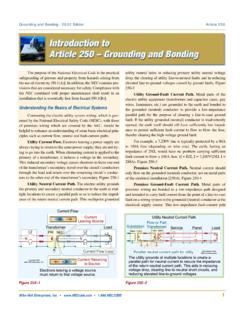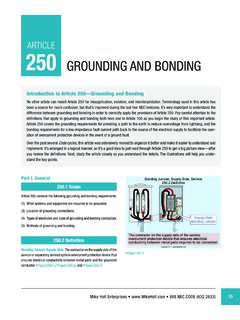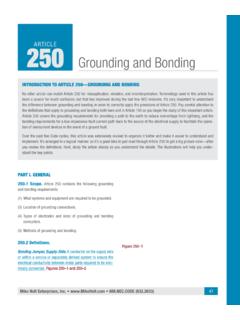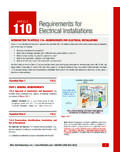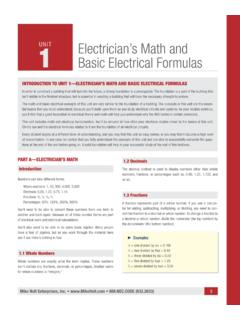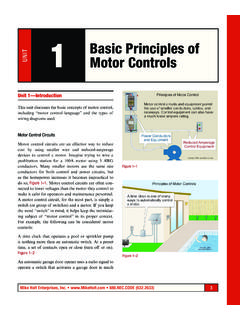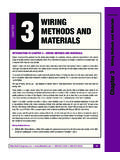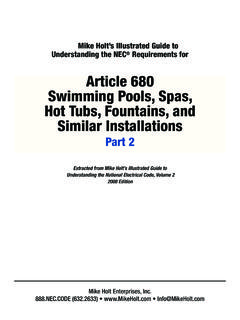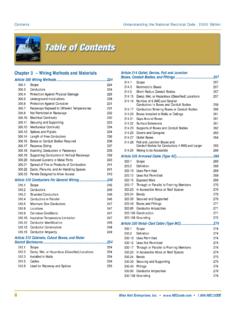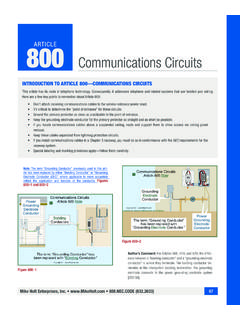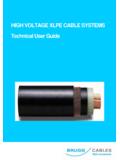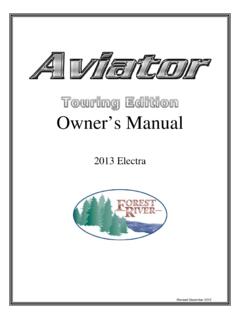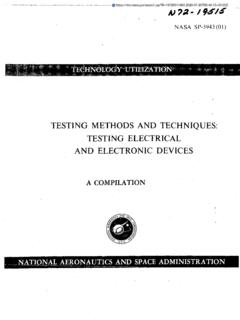Transcription of ARTICLE HAZARDOUS (CLASSIFIED) LOCATIONS
1 Mike Holt Enterprises, Inc. ( )23 ARTICLE500 HAZARDOUS (CLASSIFIED) LOCATIONSI ntroduction to ARTICLE 500 HAZARDOUS (Classified) LocationsA HAZARDOUS (classified) location is an area where the possibility of fire or explosion can be created by the presence of flam-mable or combustible gases or vapors, combustible dusts, or easily ignitable fibers/flyings. Electric arcs, sparks, and/or heated surfaces can serve as a source of ignition in such 500 provides a foundation for applying ARTICLE 501 (Class I LOCATIONS ), ARTICLE 502 (Class II LOCATIONS ), ARTICLE 503 (Class III LOCATIONS ), and ARTICLE 504 (Intrinsically Safe Systems) all of which immediately follow ARTICLE 500. This ARTICLE also provides a foundation for applying Articles 510 through you apply any of the articles just mentioned, you must understand and apply ARTICLE 500 which is fairly long and detailed.
2 You ll notice when studying this ARTICLE that there are many Informational Notes that you should review. Although Informational Notes aren t NEC requirements [ (C)], they contain information that help Code users better understand the related NEC Fire Triangle (fuel, oxygen, and energy source) helps illustrate the concept of how combustion occurs. Figure 500 1 nFuel. Flammable gases or vapors, combustible dusts, and easily ignitable fibers/flyings. nOxygen. Air and oxidizing atmospheres. nIgnition Source. Electric arcs or sparks, heat-producing equipment such as luminaires and motors, failure of transformers, coils, or solenoids, as well as sparks caused by metal tools dropping on metal of the graphics contained in Chapter 5 use two shades of red to identify a Division location (darker red for Division 1 and lighter red to identify Division 2).
3 In some cases, these color schemes are used as a back-ground color to help you tell if the graphic applies to Division 1, Division 2, or both (split color background).Figure 500 1 Mike Holt s Illustrated Guide to HAZARDOUS LOCATIONS based on the 2014 National electrical | HAZARDOUS (Classified) LOCATIONS ARTICLE 511. Commercial Garages, Repair, and Storage ARTICLE 513. Aircraft Hangars ARTICLE 514. Motor Fuel Dispensing Facilities ARTICLE 515. Bulk Storage Plants ARTICLE 516. Spray Application, Dipping, and Coating Processes ARTICLE 517. Health Care DefinitionsThe definitions contained in apply to Articles 500 through 504 and Articles 510 through Dust. Dust particles that are 500 microns or smaller and present a fire or explosion hazard when dispersed and ignited in s Comment:n The size of the material may be a significant factor in distin-guishing dust (Class II) from fibers and flyings (Class III).
4 Dust-Ignitionproof. Equipment enclosed in a manner that excludes dust and doesn t permit arcs, sparks, or heat inside the enclosure to ignite accumulations or suspensions of a specified dust on or in the vicinity of the Enclosures constructed so that dust won t enter under specific test conditions. Examples of dusttight enclosures include FS boxes and bell boxes. Figure 500 Scope Articles 500 Through 504To prevent injury, death, or extensive damage to structures from fires or explosions, the NEC contains stringent requirements for equip-ment and its installation in HAZARDOUS (classified) LOCATIONS where fire or explosion hazards may exist due to flammable gases, flammable liquid-produced vapors, combustible liquid-produced vapors, combus-tible dusts, or fibers/flyings.
5 The specific requirements for electrical installations in HAZARDOUS (classified) LOCATIONS are contained in: ARTICLE 501. Class I Flammable or Combustible Liquid-Produced Vapors or Flammable Gases ARTICLE 502. Class II Combustible Dust ARTICLE 503. Class III Easily Ignitible Fibers/Flyings ARTICLE 504. Intrinsically Safe SystemsAuthor s Comment:n See the definition of Structure in ARTICLE Locating electrical wiring and equipment outside a classified location provides the safest electrical installation and is often more cost-effective [ (A) Note].n Many of the graphics contained in Chapter 5 use two shades of red to identify a Division location (darker red for Division 1 and lighter red to identify Division 2). In some cases, these color schemes are used as a background color to help you tell if the graphic applies to Division 1, Division 2, or both (split color background).
6 N The NEC doesn t classify specific HAZARDOUS (classified) LOCATIONS , except as identified in Articles 511 through 517. Determining the classification of a specific HAZARDOUS area is the responsibility of those who understand the dangers of the products being used, such as the fire marshal, plant facility engineer, or insurance underwriter. It isn t the responsibility of the electrical designer, electrical contractor, or electrical inspector. Prior to performing any wiring in or near a hazard-ous (classified) location, contact the plant facility and design engineer to ensure that proper installation and materials are used. Be sure to review (B) for additional standards that might need to be articles in Chapter 5 containing specific HAZARDOUS installation requirements include: ARTICLE 505.
7 Class I, Zone 0, 1, and 2 LocationsFigure 500 2 Mike Holt Enterprises, Inc. ( )25 HAZARDOUS (Classified) LOCATIONS | General(A) Classification Documentation. All HAZARDOUS (classified) LOCATIONS must be properly documented. The documentation must be available to those who are authorized to design, install, inspect, maintain, or operate the electrical s Comment:n Proper documentation of HAZARDOUS areas assists the designer, installer, and authority having jurisdiction in ensur-ing compliance with the stringent requirements contained in Articles 501 517 of the To ensure compliance with the above requirements, some authorities having jurisdiction require drawings that indicate HAZARDOUS (classified) location areas and their classification.(B) Other Standards.
8 Important information related to topics covered in Chapter 5 may be found in other 1: To ensure a proper and safe installation, the authority having jurisdiction should be familiar with the industry involved and standards of the National Fire Protection Association (NFPA), the American Petroleum Institute (API), and the International Society of Automation (ISA).Note 2: For further information on the classification of LOCATIONS , see: Recommended Practice for the Classification of Flammable Liquids, Gases, or Vapors and of HAZARDOUS (Classified) LOCATIONS for Electri-cal Installations in Chemical Process Areas, NFPA 497 Standard for Dipping and Coating Processes Using Flammable or Combustible Liquids, NFPA 34 Area Classification in HAZARDOUS (Classified) Dust LOCATIONS , ISA Flammable and Combustible Liquids Code, NFPA 30 Recommended Practice for Classification of LOCATIONS of electrical Installations at Petroleum Facilities Classified as Class I, Division 1 and Division 2, ANSI/API RP 500 Standard for Spray Application Using Flammable or Combustible Materials, NFPA 33 Liquefied Petroleum Gas Code, NFPA 58 Standard for Fire Protection in Wastewater Treatment and Collection Facilities, NFPA 820 Note 3: For further information on protection against static electricity and lightning hazards in HAZARDOUS (classified) LOCATIONS , see:Hermetically Sealed.
9 Equipment sealed against the entrance of an external atmosphere. Figure 500 3 Oil Immersion. electrical equipment immersed in a protective and Pressurized.(1) Purging (Class I). Supplying an enclosure with a protective gas at a sufficient positive pressure to reduce the concentration of any flam-mable gas or vapor.(2) Pressurization (Class I or II). Supplying an enclosure with a pro-tective gas with or without continuous flow at sufficient pressure to prevent the entrance of a flammable gas or vapor, a combustible dust, or an ignitible Other ArticlesExcept as modified in Articles 500 through 504, all installation require-ments contained in Chapters 1 through 4 of the NEC apply to electrical equipment and wiring installed in HAZARDOUS (classified) 500 3 Mike Holt s Illustrated Guide to HAZARDOUS LOCATIONS based on the 2014 National electrical | HAZARDOUS (Classified) LocationsAuthor s Comment:n The same building or structure might contain any combina-tion of Class I, Division 1 and 2 LOCATIONS ; Class II, Division 1 and 2 LOCATIONS .
10 And/or Class III, Division 1 and 2 See the definitions of Building and Structure in ARTICLE 100.(B) Identification of a Class I Location. A Class I location is an area where flammable gases, flammable liquid-produced vapors, or com-bustible liquid-produced vapors may be present in quantities sufficient to produce explosive or ignitible mixtures.(1) Class I, Division 1 Location. A Class I, Division 1 location is a location in which: Figure 500 5(1) Ignitible concentrations of flammable gases, flammable liquid- produced vapors, or combustible liquid-produced vapors may exist in the course of normal operations, or (2) Ignitible concentrations of flammable gases, flammable liquid- produced vapors, or combustible liquids above their flash points may exist frequently due to repair or maintenance operations or because of leakage, or(3) Breakdown or faulty equipment releases ignitible concentrations of flammable gases, flammable liquid-produced vapors, or com-bustible liquid-produced vapors and the electrical equipment becomes a source of ignition.
